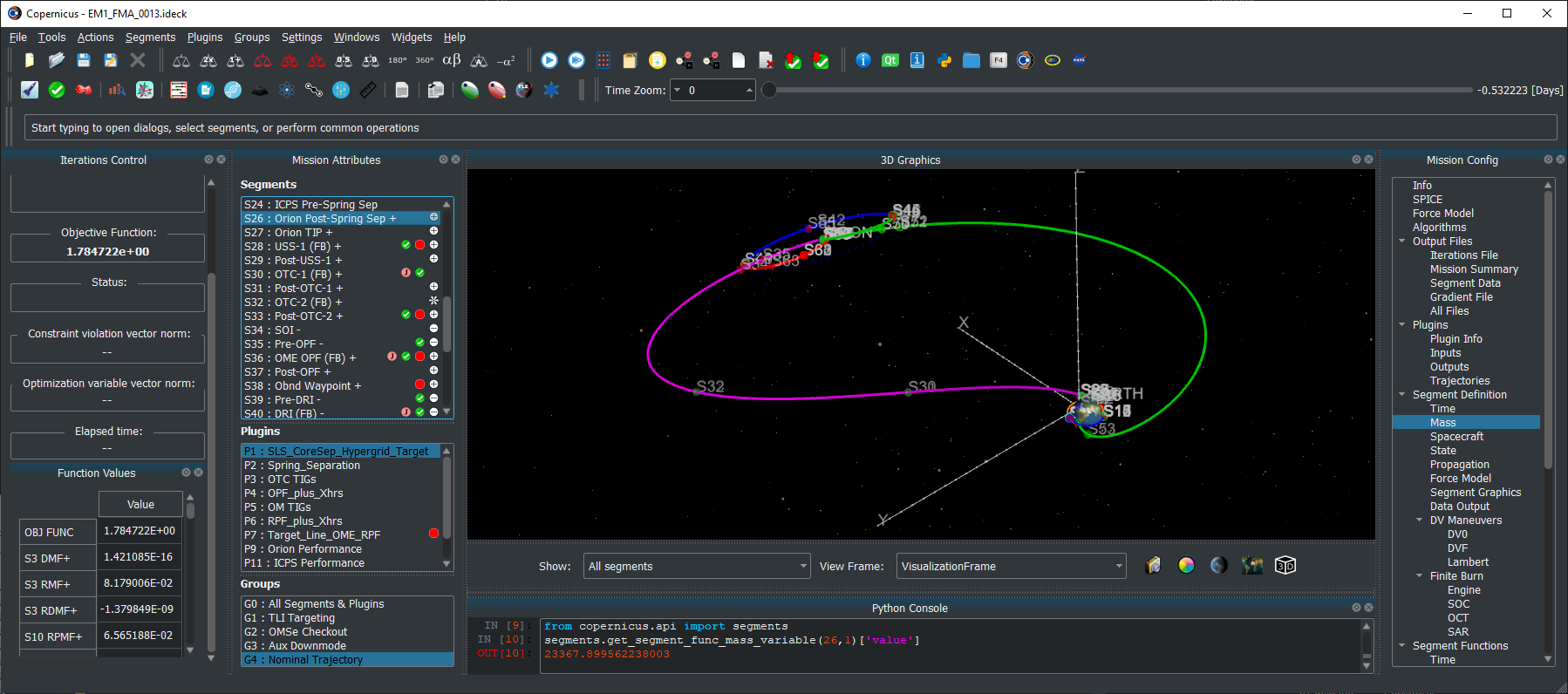
Copernicus, a generalized spacecraft trajectory design and optimization system, is capable of solving a wide range of trajectory problems such as planet or moon centered trajectories, libration point trajectories, planet-moon transfers and tours, and all types of interplanetary and asteroid/comet missions.
- August 13, 2024: Copernicus Version 5.3.2 is now available.
- December 18, 2023: Copernicus Version 5.3.1 is now available. This is a bugfix release.
- November 15, 2023: Copernicus Version 5.3 is now available. This update includes many bug fixes and various new features and refinements. Including: a new Copernicus mission file format, updates to kernels, a significant expansion of the beta Python API, and various new integration methods. In addition, we have upgraded to Python 3.10, and all dependencies are now obtained via conda.
- January 21, 2022: Copernicus Version 5.2 is now available. This update includes many bug fixes and various new features and refinements.
- June 17, 2021: Copernicus was selected as winner of the 2021 NASA Software of the Year Award.
- March 4, 2021: Copernicus Version 5.1 is now available. This update includes many bug fixes and various new features and refinements.
- June 26, 2020: Copernicus Version 5.0 is now available. This is a significant update to Copernicus and includes: A new modern Python-based GUI that is now cross-platform and fully functional on Windows, Linux, and macOS, 3D graphics upgrades including antialiasing and celestial body shadowing, a new Python scripting interface, many other new features and options, and bug fixes.
- May 1, 2018: Copernicus Version 4.6 is now available. The release includes the following changes: a new cross-platform JSON kernel file format, various new reference frame features, including new capabilities for user-defined reference frame plugins, and numerous bug fixes and other minor enhancements.
- January 24, 2018: Copernicus Version 4.5 is now available. The new version includes a new experimental Mac version, faster exporting of segment data output files (including the addition of a new binary HDF5 format), some new GUI tools, new plugin capabilities, and numerous other new features and bug fixes.
- October 1, 2016: Copernicus Version 4.4 is now available. The new version includes 3D graphics improvements and various other new features and bug fixes.
- February 8, 2016: Copernicus Version 4.3 is now available. The new version includes updates to the plugin interface, a new differential corrector solution method, updated SPICE SPK files, updates to the Python interface, new training videos, as well as numerous other refinements and bug fixes.
- July 21, 2015: Copernicus Version 4.2 is now available. The update includes further refinements to the new plugin feature, as well as various other new features and some bug fixes.
- April 13, 2015: Copernicus Version 4.1 is now available. This update includes a new plugin architecture to enable extending Copernicus with user-created algorithms. It also includes a new Python interface, as well as various other new features and bug fixes.
- August 13, 2014: Copernicus Version 4.0 is now available. This is an update to version 3.1, which was released in June 2012. The new release includes many new features, bug fixes, performance and stability improvements, as well as a redesigned GUI, a new user guide, and full compatibility with Windows 7. The update is recommended for all Copernicus users.
The Copernicus Project started at the University of Texas at Austin in August 2001. In June 2002, a grant from the NASA Johnson Space Center (JSC) was used to develop the first prototype which was completed in August 2004. In the interim, support was also received from NASA's In Space Propulsion Program and from the Flight Dynamics Vehicle Branch of Goddard Spaceflight Center. The first operational version was completed in March 2006 (v1.0). The initial development team consisted of Dr. Cesar Ocampo and graduate students at the University of Texas at Austin Department of Aerospace Engineering and Engineering Mechanics. Since March 2007, primary development of Copernicus has been at the Flight Mechanics and Trajectory Design Branch of JSC.
The National Aeronautics and Space Act of 1958 and a series of subsequent legislation recognized transfer of federally owned or originated technology to be a national priority and the mission of each Federal agency. The legislation specifically mandates that each Federal agency have a formal technology transfer program, and take an active role in transferring technology to the private sector and state and local governments for the purposes of commercial and other application of the technology for the national benefit. In accordance with NASA's obligations under mandating legislation, JSC makes Copernicus available free of charge to other NASA centers, government contractors, and universities, under the terms of a US government purpose license. Organizations interested in obtaining Copernicus should click here.






